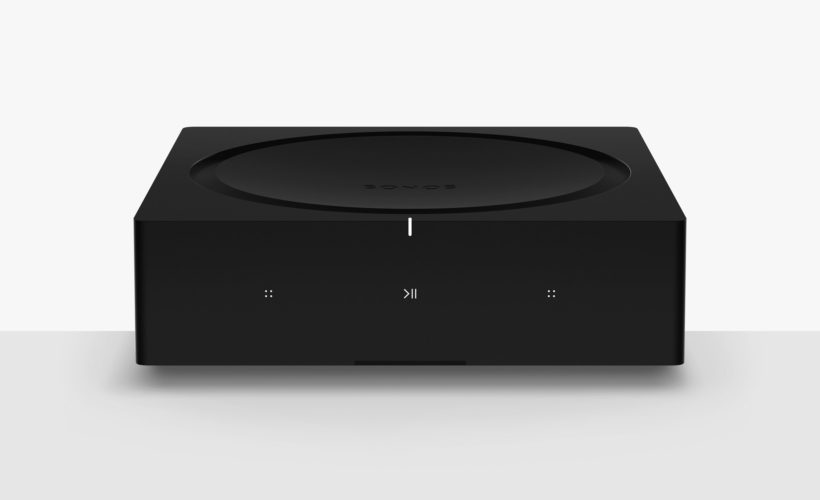It took the brisk Copenhagen air and honest feedback from a trusted colleague to teach Benji Rappoport the lesson he should have already known.
In early 2017, Rappoport was several months into his first assignment as a Product Manager at Sonos. His task: re-imagine the Connect:Amp, a decade old plastic box that hit shelves when the iPod Touch was bleeding-edge tech. Unlike newer Sonos products, it wasn’t a smart speaker. It was an amplifier that tethered to a pair of “dumb” speakers, creating a more traditional-looking stereo system with all the wireless multiroom bells and whistles one would expect from Sonos.
The original Sonos Connect:Amp from 2007.
Rappoport and lead industrial designer Philippe Vossel gathered in a conference room in the company’s small Copenhagen office along with Cristoffer Arensbach, the CEO of Danish high-end audio dealer and installer Hi-Fi Klubben. Like other installers Rappoport had met with—and more than a hundred his team surveyed—Arensbach liked the aging Connect:Amp, but felt it wasn’t as powerful or capable as it could be for robust speaker installations. After a decade on the market, it was long in the tooth.
Next, Rappoport pulled out three distinctly shaped cardboard boxes. One looked like a shoebox, and another resembled a personal-size pizza box from Pizza Hut. The last was taller and thinner, like a rectangular liquor bottle box standing upright. All three of these shapes were being proposed as the form factor for the next Sonos Amp.
Rappoport’s cardboard mock-ups.
Rappoport loved the radical, unique shape of the tall bottle box. It made a statement, he thought, and he was eager for validation from a longtime Sonos dealer. But Arensbach didn’t like it. “He literally pointed at the one that I was savoring and was like, ‘Yeah, not that,'” Rappoport says. The immediate rejection of the Bottle put him on the defense. “I was like, ‘Well why not?’ He said, ‘I can’t imagine that living on a rack.'”
The shoebox design didn’t impress Arensbach either. (Since he was calling it “the shoebox,” Rappoport jokingly wonders, did it ever stand a chance?) The pizza box was the clear winner, not because it was the coolest looking, but because it made the most sense for the installer.
Consumers prefer Sonos’ sleek standalone speakers, but one of the biggest customer bases for the Amp is professional installers. For them, practicality is paramount, and that means the product needs to fit flawlessly into the standard 19-inch audio racks the pros use for their custom multiroom audio installations.
After that meeting, Arensbach took Rappoport and Vossel to see one of Hi-Fi Klubben’s retail stores. It had a room of streaming amplifiers and speakers lined up in neatly organized wooden shelves and cubbyholes. Though the Connect:Amp still sold well, Rappoport noticed it had migrated down into the very bottom corner of the display. Later, he observed many standard rack setups (commonly found in the garages or hall closets of custom home audio installations) also tended to hide the old Connect:Amp when possible. Like a dinosaur that had somehow survived extinction, it looked unwelcome and out of place.
Dealing in Details
Sonos users may be surprised to learn there’s a thriving market of affluent folks who hire professionals to install Sonos systems in their homes. Sonos doesn’t spend much effort talking about installers, and you could make the argument that Sonos became a household name—and a publicly traded company—in the last decade by selling millions of households on the idea that they don’t need to hire a professional installer to create an amazing multiroom speaker setup.
But from the very start, with 2005’s ZP100 amplifier, professional installers proved to be some of Sonos’ strongest advocates. Sonos systems didn’t always make the installers as much money as large-scale custom builds, but customers liked the features and reliability. If an installer sold a client a Sonos system instead of a more expensive setup with a CD changer and complex amp hardware, it often meant they’d receive fewer angry calls about speakers not working. As time went on, Sonos let its Amps languish and shifted focus to standalone speakers. Yet installers still stuck with the old hardware, working harder and harder to come up with ways to jury-rig the underpowered Connect:Amp into increasingly complex home networks.
Today, Sonos is debuting a new version of the Amp, and professional installers will get first crack at it. They’ll be able to buy the $599 Sonos Amp starting December 1, months before its February 2019 public launch. In the past year, Sonos has expanded what it now calls its “Installed Solutions” department, launching a freight program and co-op funding for its installation partners. Soon it will treat them to a new web portal offering dedicated support, community features, early info on upcoming products, and promotional help. All Sonos customers will begin to notice additions to Sonos.com that help match them with installers, in case they have grander ambitions for their home speaker network.
Respect the Rack
Everything about the new Sonos Amp should please pro installers. The Amp can connect to four speakers, twice as many as before. The power output has been doubled; the new Amp delivers 125 watts per channel with an impressive signal-to-noise ratio of 116dB and low harmonic distortion measurement of 0.1 percent.
Six of the new Amps in an installation rack.
These improvements come in a stackable package that’s about 1.5 rack units (2.5 inches) tall. Rappoport likes to joke that the 60-person product and operations team had a mission to “respect the rack.” The Amp accepts standard banana plugs for speaker connections and can be secured to a rack with standard screws. Even the color is affectionately called “rack black.”
“What became completely apparent was that a rack is a representation of the craft,” Rappoport says. “It’s not just four metal uprights with some shelves and some panels around it. It is an outward expression of the craftsmanship of the installer.”
Respecting the rack wasn’t easy. Squeezing more power within a small frame inevitably leads to overheating. Since the team couldn’t attach a ton of bulky heatsinks or fans to keep the Amp cool, they used the inner metal chassis of the Amp itself as a heatsink to dissipate the higher levels of heat radiating from within the box. The circular design adorning the top (which makes the Amp look a little like an old Sega Dreamcast) also vents warm air.
These changes were the result of some serious stress testing. “We’ve tested relentlessly,” says Rappoport. “We’ve gone beyond emissions testing, thermal testing, and drop testing. We’ve poured cola in the thing. We’ve tried to drop coins and other metal objects into it. We did all this because the result we know we need to deliver is the insane, impressive power that we wanted with Sonos reliability.”
Symbiotic Sonos
The clean design and new skills may even free the Amp from rack purgatory and let the device integrate more fully with the increasingly complex ecosystem of connected devices for the home.
The Amp is now TV friendly, like the Sonos Beam, with an onboard HDMI ARC connection and IR receiver, and makes a good option for home theaters with wired front or rear speakers, or ceiling-mounted speakers. Recognizing it cannot do it all, Sonos is now partnering with a company called Sonance to extend TruePlay tuning and networking abilities to a new line of embedded speakers.
The new Amp also supports AirPlay 2, Alexa, Google Assistant (soon), and other Sonos network features, though it doesn’t have onboard mics itself. The new mono mode and volume limiting controls will also aid some setups, as will the new developer controls Sonos plans to open. With that programming interface, developers can write code to make Sonos speakers provide notifications from smart-home devices, or play custom audio clips. Support for the customizable web service IFTTT is also planned.
Sonos isn’t working this tightly with installers out of the goodness of its heart. With the expansion of smart-home tech and a move toward high-end “architectural” audio integrations in homes, more customers are relying on professional installers to create complex setups where audio devices, video screens, lights, and appliances all work together.
“When we started, multiroom audio was really complicated. We made it a lot simpler,” Rappoport says. “Now the context is completely different, and what’s complicated is the smart home.”
More Great Stories
-
Meet the Man Who’s Building Sonos’ Audio Internet
-
These are The Best Sonos Speakers
-
How Sonos Made Alexa Sound Amazing
-
Looking for more? Sign up for our daily newsletter and never miss our latest and greatest stories
Source:WIRED











